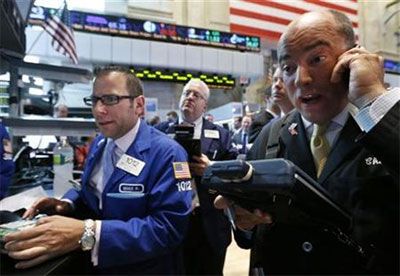 US stocks staged a dramatic recovery off their lows on Monday, helped by a turnaround in Apple's shares, but the three main indexes remained in or within spitting distance of correction territory amid fears China's growth is slowing.
US stocks staged a dramatic recovery off their lows on Monday, helped by a turnaround in Apple's shares, but the three main indexes remained in or within spitting distance of correction territory amid fears China's growth is slowing.
The Dow Jones industrial average - which fell into the correction zone on Friday - briefly slumped more than 1,000 points, its biggest point-drop ever. At midday, the Dow was down about 243 points or 1.48 per cent as bargain hunters stepped in.
The Dow has never lost more than 800 points in a day.
"The US fundamentals are strong and just as confidence can go away, it can come back pretty quickly if the fundamentals are sound," said Brad McMillan, chief investment officer for Commonwealth Financial Network in New York.
"Investors are starting to look at things rationally and see that things aren't that bad and start to pick up stocks like Apple."
Apple shares, which slid as much as 13 per cent, reversed course to trade up 1.5 per cent at $107.36 at noon.
Apple's rally helped the Nasdaq composite and the S&P 500 index pull away from levels that would have put them into correction mode.
An index is considered to be in correction when it closes 10 per cent below its 52-week high.
At 12:10 p.m. ET (1610 GMT) the Dow Jones industrial average was down 222.45 points, or 1.35 per cent, at 16,237.3, the S&P 500 was down 28.06 points, or 1.42 per cent, at 1,942.83 and the Nasdaq Composite was down 36.12 points, or 0.77 per cent, at 4,669.92.
All 10 major S&P 500 sectors fell, with energy and finance losing about 3 per cent. All 30 stocks on the Dow and more than 90 per cent of the S&P 500 stocks were down 10 per cent or more from their 52-week highs.
The CBOE Volatility index, a measure of the premium traders are willing to pay for protection against a drop in the S&P 500, jumped as much as 90 per cent to 53.29, its highest since January 2009.
The S&P 500 index showed 185 new 52-week lows and just two highs, while the Nasdaq recorded 589 new lows and six highs.
The lack of new measures from Beijing to support Chinese stocks following an 11 per cent drop last week sparked a plunge in global equities and a selloff in oil and commodities.
Oil was down about 4 per cent to a 6-1/2-year low, while London copper and aluminum futures hit their lowest since 2009.
Oil majors Exxon and Chevron recovered somewhat to trade down about 3 per cent, having fallen more then 6 per cent earlier in the day. US oil and gas stocks have already lost about $310 billion of market value this year.
The dollar index was down 1.7 per cent. It fell more than 2 per cent earlier to a 7-month low as the probability of a September rate hike receded.
Traders now see a 24 per cent chance that the Federal Reserve will increase rates in September, down from 30 per cent late on Friday and 46 per cent a week earlier, according to Tullett Prebon data.
Wall Street's selloff shows investors are becoming increasingly nervous about paying high prices for stocks at a time of minimal earnings growth, tumbling energy prices, and uncertainty around a rate hike.
Alibaba was down 1.9 per cent at $66.89, below its IPO price of $68, making it the second high-profile tech company to fall below its IPO price in the past week after Twitter on Thursday.
Futures on the Nasdaq, S&P and Dow indexes were halted briefly before the market opened after hitting a circuit breaker, a step taken by exchanges to reduce volatility and give investors time to assess information.
The New York Stock Exchange invoked a rarely used rule saying market makers don't have to disseminate price indications before the opening bell in an effort to make it easier and faster to open stocks on a volatile trading day.
Declining issues outnumbered advancers on the NYSE by 2,889 to 266. On the Nasdaq, 2,326 issues fell and 520 advanced.






